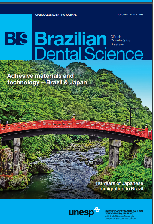Non-thermal plasma increase bond strength of zirconia to a resin cement
DOI:
https://doi.org/10.14295/bds.2018.v21i2.1562Abstract
Objective: This study investigated the influence of different surface treatments on zirconia surface energy, roughness and microshear bond strength. Material and Methods: Forty eight slices of Yttria-stabilized tetragonal zirconia polycrystal (Y-TZP- VITA In-Ceram® YZ for inLab®) (6.4 x 3.2 x 1.6 mm) were divided into 3 groups according to the surface treatment (n = 16): YTZP_control -untreated; YTZP_plasma -surface treatment with non-thermal oxygen plasma; YTZP_primer - coating with ceramic primer. Surface energy (n = 6) was measured with a goniometer; and surface roughness (n = 10) was analyzed with a 3D profilometer were performed over zirconia surface. On the same specimens of surface roughness, on the treated zirconia's surface, resin cement (PANAVIA V5 - Kuraray Noritake Dental) was built up by inserting the resin cement into Tygon tubes (1 mm of internal diameter X 1 mm length). After 24 h storage, microshear test was assessed. Data were analyzed by one-way ANOVA and Tukey post-hoc test (p < 0.05). Results: Non-thermal oxygen plasma treated specimens exhibited higher statistically significant surface energy (p = 0.00) and bond strength (p = 0.00) when compared to control and primer groups. Roughness test (p = 0.897) could not detect statistical difference among the tested groups.
Conclusion: Non-thermal oxygen plasma should be a suitable alternative for zirconia surface treatment prior to luting hence it improved microshear bond strength and provided higher surface energy without affecting surface roughness.
Keywords
Adhesion; Non-thermal plasma; Surface treatment.
Downloads
Downloads
Additional Files
Published
How to Cite
Issue
Section
License
Brazilian Dental Science uses the Creative Commons (CC-BY 4.0) license, thus preserving the integrity of articles in an open access environment. The journal allows the author to retain publishing rights without restrictions.
=================




























